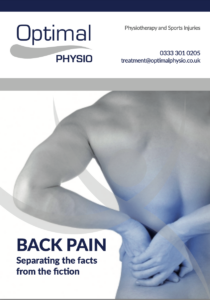As a patient, understanding when to seek advanced imaging like X-rays or MRIs for your back pain is crucial for receiving appropriate and timely treatment. While both X-rays and MRIs are valuable diagnostic tools, they serve different purposes in assessing back-related issues. In this blog, we will explore the differences between X-rays and MRIs, when each imaging technique is appropriate, and the benefits they offer to help you make an informed decision regarding your back pain management.
Unfortunately most people choose to see their GP first if they are suffering with low back pain. The most common feedback is that they have been given pain relief like paracetomol, ibuprofen or tramadol/co-codomol and told to rest. This approach is not evidence based and leads to worse long term outcomes.
As this does not resolve the underlying issue most people with low back pain then feel very frustrated and stuck. They don’t know what to do, so they return to their GP who will then either refer them for a X-ray, MRI or send them for physiotherapy. If this is within the NHS the waiting list could be as much as 6 months. Often patients then choose to go private in order to get seen quicker and get back to enjoying life with freedom of movement again.
The longer the pain, the more doubt the patient has. It’s normal for people with back pain to worry and think it is something more serious and therefore, need a scan or an x-ray to get the answers to their struggles.
Sadly this is not the case. Pain is far more complex and the solution often does not require this intervention.
So what is the point of X-rays and MRI scans and when are they appropriate?
X-ray for Back Pain
X-rays are a common first-line imaging tool used to evaluate bone structures and joint alignment. They are particularly helpful in identifying fractures, dislocations, and degenerative changes in the spine. If you’ve experienced a recent injury, fall, or trauma to your back, an X-ray can quickly detect any potential fractures or dislocations. If you have not had a fall or significant trauma an x-ray is unlikely to be of benefit.
Advantages of X-rays:
1. Quick and accessible: X-rays are readily available in most medical facilities and provide rapid results.
2. Low radiation exposure: The amount of radiation used in X-rays is relatively low and generally considered safe.
3. Cost-effective: X-rays are typically more affordable compared to other advanced imaging techniques.
However, X-rays have limitations when it comes to assessing soft tissues such as muscles, discs, and nerves. For this reason, if your back pain persists or if your doctor or physiotherapist suspects issues beyond bone-related problems, further investigation through MRI might be recommended.
MRI for Back Pain
Magnetic Resonance Imaging (MRI) is a powerful diagnostic tool that uses strong magnets and radio waves to create detailed images of soft tissues, including muscles, ligaments, tendons, and spinal discs. MRIs are exceptionally useful in identifying herniated discs, spinal stenosis, nerve compression, and other soft tissue abnormalities contributing to back pain. They are expensive and can cost up to £800 privately.
Advantages of MRI:
1. Detailed soft tissue visualization: MRI provides high-resolution images of the structures surrounding the spine, allowing for precise diagnoses.
2. Non-invasive and painless: Unlike certain diagnostic procedures, MRI is a non-invasive technique that does not involve radiation exposure.
3. Comprehensive evaluation: MRIs can reveal a wide range of spinal abnormalities, even those that might not be apparent on X-rays.
When to Consider an MRI:
1. Persisting or worsening symptoms: If your back pain persists for several monthsand you don’t respond to or tolerate physiotherapy treatment then further investigations will likely include a MRI.
2. Suspected nerve issues: If you have symptoms like shooting pain, numbness, or tingling radiating down your leg, it could indicate nerve compression, making an MRI essential for a comprehensive diagnosis.
3. Chronic back pain without injury: If your back pain is not related to any recent injury or trauma, an MRI can help detect potential underlying issues or rule out more serious or sinister causes. This is indicated only after a significant period of rehab with a physiotherapist or with an orthopaedic consultant
Does Pain correlate with the findings on an X-ray or MRI?
Pain does not always directly correlate with findings on an MRI or X-ray. The relationship between pain and imaging results can be complex, and it’s essential to understand that imaging findings do not always explain the entirety of a person’s pain experience. There are several reasons why pain may not necessarily correlate with what is seen on MRI or X-ray:
1. Non-visible factors: Pain can be influenced by various factors that are not visible on imaging studies. These factors may include inflammation, nerve sensitivity, muscle spasms, and psychological aspects like anxiety or depression. These elements contribute to pain but may not be captured by standard imaging.
2. Degenerative changes: As people age, degenerative changes in the spine are relatively common. Many individuals, especially older adults, may show signs of disc degeneration, osteoarthritis, or other age-related changes on imaging. However, not everyone with these findings experiences pain. In some cases, these changes are considered a normal part of the aging process and may not be directly related to the person’s pain.
3. Structural abnormalities: An MRI or X-ray might reveal structural abnormalities like herniated discs or spinal stenosis. While these findings can be associated with pain, they do not guarantee that the specific abnormalities are the sole cause of the pain. Many people with structural abnormalities do not experience significant pain or may find relief through conservative treatments.
4. Central sensitization: Chronic pain conditions can involve changes in the nervous system’s processing of pain signals. This phenomenon, known as central sensitization, means that the brain and spinal cord become more sensitive to pain, amplifying the pain experience. Central sensitization may persist even after the initial injury or issue has healed, leading to ongoing pain even when imaging shows improvement.
5. Psychological and social factors: Pain is a multifaceted experience influenced by emotional, social, and lifestyle factors. Stress, anxiety, work-related issues, and other psychosocial factors can influence pain perception and intensity, independent of imaging findings.
While imaging studies like MRI and X-ray provide essential information for diagnosing certain medical conditions and guiding treatment decisions, they do not always directly correlate with the level of pain experienced by an individual. Pain is a complex and subjective experience influenced by various factors, and a comprehensive approach that considers both imaging results and the patient’s clinical history is essential for accurate diagnosis and effective pain management. It is crucial to work closely with healthcare professionals, such as physiotherapists, doctors, and pain specialists, to develop a tailored treatment plan that addresses the individual’s unique pain experience and needs.
Both X-rays and MRIs play vital roles in diagnosing back pain, but they offer different insights into the condition of your spine. X-rays are effective for assessing bone-related problems and recent injuries, while MRIs provide detailed images of soft tissues, such as muscles and spinal discs.
If your back pain is not resolving or if there are indications of soft tissue involvement, an MRI is usually the next step in your diagnostic journey if you are a suitable surgical candidate.
It is crucial to work closely with your healthcare provider, such as a physiotherapist or specialist, to determine the appropriate imaging based on your symptoms and medical history. Remember that imaging alone may not be sufficient to devise an effective treatment plan; physiotherapy and other conservative approaches should complement the diagnostic process to promote a successful recovery and long-term back health.
Scans only show something truly important in less than 5% of people with back pain.
Disc bulges, disc degeneration, herniated discs and arthritic changes are prevalent in people without back pain. These findings are normal and are an indication of ageing and genetics, not predictors of pain. Discovering you have these changes in the spine can lead to fear, distress and avoidance of activity.
An experienced healthcare professional would usually be able to identify if a scan was necessary based on symptoms and medical history.
This means that a very small percentage benefit from MRI results and these results must link with the clinical presentation. The majority of orthopaedic consultants will not consider surgery unless physiotherapy has been unsuccessful. Back pain surgery and investigations are usually only for referred leg pain and do not guarantee a resolution of your low back pain. If you have acute or chronic low back pain physiotherapy should always be your first course of action.
Book an appointment at our Largs or Clarkston physiotherapy clinics to find out more about how physiotherapy can help with back pain.
To book an initial assessment please call our team on 0333 301 0205
If you are not sure if you need a physio or a scan, why not come in for a free 15 minute consultation in one of our Fit for Physio slots?
For more information on low back pain please click here



0 Comments